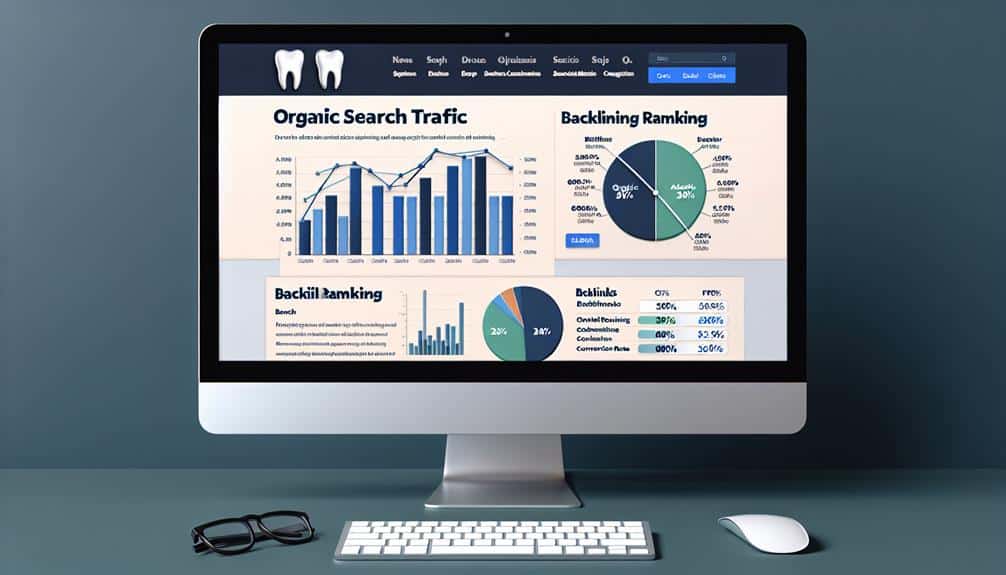As a dentist striving for SEO success, you know that your online presence is crucial in attracting new patients and growing your practice. But in the vast landscape of digital marketing, where do you start? Which metrics should you focus on to ensure that your website is performing at its best?
Well, imagine your website is a dental clinic. Just like a well-run clinic, your website needs to be efficient, user-friendly, and able to attract and retain patients. In this discussion, we will explore the key metrics that dentists should monitor to optimize their website’s performance and boost their SEO rankings.
So, let’s take a closer look at the tools you need to keep your online clinic running smoothly.
Key Takeaways
- Organic Search Metrics: Dentists should monitor organic search traffic and key SEO metrics to understand the relevance and visibility of their dental practice online. Utilizing tools like Google Analytics can help track organic visits, keywords, and landing pages. Content optimization and link building strategies are important for driving organic traffic.
- Keyword Metrics: Dentists should monitor rankings for specific keywords to evaluate their optimization efforts. Focusing on long tail keywords and location-specific terms can attract targeted and local patients. SEO strategies should be adjusted based on keyword ranking performance to maximize visibility to the right audience.
- Click-Through Rate (CTR): Closely monitoring the website’s CTR is crucial for measuring SEO success. It helps evaluate the effectiveness of ad targeting and user engagement strategies. Analyzing CTR data can identify areas for improvement. A higher CTR indicates appealing content and effective targeting, while a low CTR may indicate off-target ads or unengaging content.
- Conversion Rate: Dentists should measure the percentage of visitors taking desired actions on their website. Optimizing website design for user-friendliness, clear calls-to-action, and effectively communicating the benefits of dental services can help engage visitors. Simplifying and streamlining contact forms is also important. Tracking user behavior and analyzing it using tools can help identify areas for improvement in order to increase the conversion rate.
Organic Search Traffic
You can monitor the organic search traffic to your dental website by analyzing key SEO metrics. This will provide you with valuable insights into the effectiveness of your content optimization and link building strategies.
By tracking organic search traffic, you can measure the number of visitors who arrive at your website through search engine results pages (SERPs) without any paid advertising. This metric is essential for understanding how well your website is performing in terms of attracting organic traffic, which is highly valuable as it indicates the relevance and visibility of your dental practice online.
To effectively monitor organic search traffic, you can utilize tools like Google Analytics. This platform allows you to track the number of organic visits, the keywords that drive traffic to your site, and the landing pages that receive the most organic traffic. By analyzing these metrics, you can identify which keywords and pages are performing well and which ones may require further optimization.
Content optimization plays a crucial role in improving your organic search traffic. By creating high-quality, relevant, and informative content that’s optimized for keywords, you can increase your website’s visibility in search engine results. Additionally, link building strategies, such as obtaining backlinks from reputable dental websites or directories, can also contribute to driving organic traffic to your site.
Keyword Rankings
Monitoring keyword rankings is an essential aspect of SEO strategy for dentists. By keeping track of how your website ranks for specific keywords, you can gain valuable insights into the effectiveness of your optimization efforts.
One key aspect to consider is the use of long tail keywords. These are more specific and targeted phrases that potential patients may use when searching for dental services. By monitoring the rankings of these long tail keywords, you can ensure that your website is appearing in relevant search results and attracting the right audience.
Additionally, monitoring keyword rankings can help with local search optimization. As a dentist, you want to attract patients from your local area. By tracking the rankings of keywords that include location-specific terms, such as ‘dentist near me’ or ‘dentist in [your city]’, you can gauge how well your website is performing in local search results.
This allows you to make adjustments to your SEO strategy as needed, ensuring that you’re maximizing your visibility to local patients.
Click-Through Rate (CTR)
To effectively measure the success of your SEO efforts, dentists must closely monitor their website’s Click-Through Rate (CTR). CTR is a crucial metric that indicates how successful your ads or organic search results are in attracting clicks from users. It measures the percentage of users who click on your website’s link out of the total number of impressions or views it receives.
Monitoring CTR helps dentists evaluate the effectiveness of their ad targeting and user engagement strategies. By analyzing CTR data, dentists can identify areas for improvement and make informed decisions to optimize their SEO campaigns. A higher CTR indicates that your website’s content and meta descriptions are appealing to users and are effectively targeting your intended audience. On the other hand, a low CTR may indicate that your ad targeting is off or that your content is not engaging enough to entice users to click.
To better understand the impact of CTR on SEO success, let’s take a look at the following table:
| CTR Range | Interpretation | Action |
| High (>5%) | Your ads or organic search results are | Maintain and optimize |
| highly engaging and targeting the right | current strategies | |
| audience. | ||
| Moderate | Your ads or organic search results are | Evaluate and make |
| (2-5%) | somewhat engaging, but there is room | adjustments to improve |
| for improvement. | CTR | |
| Low (<2%) | Your ads or organic search results are | Re-evaluate and |
| not engaging users effectively or | revamp ad targeting and | |
| targeting the right audience. | content strategies |
Conversion Rate
The conversion rate is a critical metric that measures the percentage of website visitors who take a desired action, such as making an appointment or filling out a contact form. It’s an important indicator of your website’s effectiveness in turning visitors into potential patients. By monitoring and optimizing your conversion rate, you can improve patient acquisition and maximize the ROI of your online marketing efforts.
To effectively monitor and improve your conversion rate, here are four key factors to consider:
- Website Design: A well-designed website that’s user-friendly, visually appealing, and easy to navigate can significantly impact your conversion rate. Make sure your website is responsive, loads quickly, and has clear calls-to-action to encourage visitors to take the desired action.
- Clear Messaging: Your website should clearly communicate the benefits of your dental services and why patients should choose your practice. Use compelling and persuasive language to engage visitors and encourage them to take action.
- Contact Forms: Optimize your contact forms to make them simple, intuitive, and easy to fill out. Minimize the number of required fields and provide clear instructions to streamline the process for potential patients.
- Tracking and Analytics: Implement tracking tools like Google Analytics to monitor user behavior and identify areas for improvement. Analyze conversion funnels, bounce rates, and user flow to identify any bottlenecks or barriers that may be hindering conversions.
Bounce Rate
Minimizing your website’s bounce rate plays a crucial role in optimizing user engagement and increasing the likelihood of converting visitors into potential patients. Bounce rate refers to the percentage of visitors who leave your website after viewing only one page. A high bounce rate indicates that visitors aren’t finding what they’re looking for or aren’t engaged enough to explore further.
Improving engagement and reducing bounce rate requires a strategic approach. Start by analyzing the content on your website. Is it relevant, informative, and engaging? Ensure that your website is easy to navigate and visually appealing. Make sure that your website loads quickly and is mobile-friendly, as slow loading times and a poor mobile experience can lead to higher bounce rates.
Engage visitors with compelling headlines and clear calls-to-action. Provide valuable content that addresses the needs and concerns of your target audience. Incorporate multimedia elements such as videos and images to enhance user experience. Use internal linking to guide visitors to related content on your website, keeping them engaged and reducing bounce rate.
Regularly monitor your bounce rate and make data-driven decisions to improve user engagement. By reducing bounce rate, you can increase the chances of converting visitors into potential patients, ultimately driving the success of your dental practice.
Page Load Speed
Page load speed is a critical factor that affects both your website’s search engine rankings and user experience.
From an SEO perspective, search engines like Google prioritize websites that load quickly, as it indicates a positive user experience.
Additionally, optimizing your page load speed can help reduce bounce rates and improve engagement, ultimately leading to higher conversions and improved website performance.
Speed Impact on Rankings
Improving page load speed is crucial for optimizing your website’s rankings in search engine results. A slow-loading website can negatively impact user experience and lead to higher bounce rates. To ensure your website loads quickly and efficiently, consider the following strategies:
- Optimize images: Compress and resize images to reduce their file size without compromising quality. This can significantly improve page load speed.
- Minify code: Remove unnecessary characters, spaces, and comments from your website’s HTML, CSS, and JavaScript files. This reduces file size and improves load times.
- Enable browser caching: Caching allows browsers to store website files locally, reducing the need to download them with each visit. This can greatly improve load speed for returning visitors.
- Use a content delivery network (CDN): A CDN distributes your website’s files across multiple servers geographically, reducing the distance between the server and user. This can significantly improve load times, especially for users in different regions.
User Experience Optimization
To enhance user experience and optimize page load speed, dentists can implement various strategies such as image optimization, code minification, browser caching, and utilizing a content delivery network (CDN).
Improving navigation and enhancing website aesthetics are key factors in user experience optimization. When it comes to page load speed, every second matters. Slow loading times can lead to high bounce rates and negatively impact user satisfaction.
By optimizing images and compressing code, you can significantly reduce the loading time of your website. Implementing browser caching allows users to store certain elements of your site on their device, resulting in faster subsequent visits. Additionally, utilizing a content delivery network distributes your website’s content across multiple servers, reducing the distance between users and your website, thus improving load times.
Prioritizing user experience optimization ensures that your dental website is fast, user-friendly, and visually appealing, ultimately leading to better SEO performance.
Mobile Responsiveness
Dentists should prioritize ensuring their websites are mobile responsive to optimize user experience and improve search engine rankings. In today’s digital age, more and more people are using their smartphones and tablets to browse the internet. As a result, it’s essential for dentists to embrace mobile friendly design best practices and make their websites easily accessible on mobile devices.
Here are four key factors to consider when it comes to mobile responsiveness:
- Responsive design: Implementing a responsive design allows your website to adapt and display properly on various screen sizes. This ensures that your content is easily readable and navigable, regardless of the device being used.
- Fast loading times: Mobile users expect instant access to information. Optimizing your website’s loading speed is crucial for providing a seamless browsing experience. Compressing images, minifying code, and leveraging browser caching are some techniques that can help improve loading times.
- Easy navigation: Simplify your website’s navigation menu for mobile users. Make sure it’s easy to find important information, such as contact details and appointment booking forms. Incorporate clear and intuitive buttons and links to enhance user experience.
- Mobile-friendly content: Tailor your content to suit mobile users by using concise and scannable paragraphs, bullet points, and headings. Optimize images and videos for mobile devices to prevent slow loading times.
Frequently Asked Questions
How Can Dentists Track the Effectiveness of Their SEO Efforts in Driving Organic Search Traffic to Their Website?
To track the effectiveness of your SEO efforts in driving organic search traffic to your website, you need to focus on metrics that measure your ROI and website traffic. These metrics provide valuable insights for optimizing your dental practice’s online presence.
What Are the Key Metrics Dentists Should Monitor to Assess Their Keyword Rankings for Dental-Related Search Terms?
To assess your keyword rankings for dental-related search terms, monitor metrics like search engine visibility, organic click-through rate, and average position. Also, conduct competitor analysis to understand how you compare in the search landscape.
What Is the Significance of Click-Through Rate (Ctr) for Dentists’ Websites and How Can It Be Improved?
Improving CTR for dental websites is crucial for dental SEO success. User engagement is vital in determining the effectiveness of your website. Enhancing your CTR can be achieved through compelling meta descriptions and appealing headlines.
How Can Dentists Measure the Conversion Rate of Their Website and What Are Some Strategies to Optimize It?
To measure your website’s conversion rate, track the number of visitors who complete desired actions. Optimize it by analyzing user behavior, improving website design and content, and implementing effective call-to-action strategies.
What Impact Does Bounce Rate Have on Dental Websites and How Can Dentists Reduce It to Improve User Engagement?
To improve user engagement on dental websites, dentists must understand the impact of bounce rate. By reducing bounce rate, you can keep visitors on your site longer, increase conversions, and improve your overall SEO success.
Conclusion
In conclusion, monitoring the right metrics is crucial for dental practices to achieve SEO success. By tracking organic search traffic, keyword rankings, click-through rate, conversion rate, bounce rate, page load speed, and mobile responsiveness, dentists can analyze and optimize their online presence.
These metrics provide valuable insights for making strategic decisions and ensuring a seamless user experience.
Stay tuned for our next article, where we delve deeper into effective strategies to boost your dental practice’s SEO performance.

Suraj Rana is a renowned Dental SEO Expert, deeply committed to elevating dental practices in the online landscape. With a profound understanding of technical SEO, he specializes in tailoring on-page optimization strategies specifically for the dental industry. Suraj’s extensive experience spans across various sectors, but his passion truly lies in transforming the digital presence of dental clinics. His expertise in dental-specific search engine optimization, combined with a data-driven approach, empowers him to develop strategies that significantly increase organic traffic, enhance search engine rankings for dental-related keywords, and ultimately drive business growth for his dental clients. Suraj Rana’s unique blend of SEO skills and dedication to the dental field make him an invaluable asset to any dental practice looking to thrive online.


